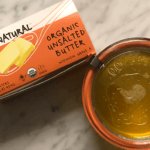
What is Ghee? What is Clarified Butter?
Ghee is a trending ingredient, but what exactly is it? It’s also considered as clarified

How to Make Ghee
- Use a heavy bottomed pan (like a dutch oven). This will help prevent burning.
- Slice butter into smaller pieces to help it melt evenly.
- Apply medium heat then reduce to medium-low to simmer.
- Once the butter is completely melted, the oil will begin to separate from the milk proteins. This protein, you will see rise to the surface.
- Use a spoon to skim the surface and discard the solids.
- This takes time as the butter oil needs to turn clear. Be patient and continue removing the solids. At this point, you have clarified butter.
- Once the milk solids are discarded, you will see other white solids will on the bottom. Leave those to reheat and darken, creating nutty flavors.
- Continue to simmer over medium-low heat. Make sure not to walk away as it will begin to change to a golden color.
- When you see the change of color and smell flavors of toffee, remove the pan from heat.
- Let cool for 3-5 minutes. Line a fine-mesh strainer with a triple layer of cheesecloth.
- Strain the butter oil. You should see the browned solids collecting in the cheesecloth. You’ve just made ghee!
- Transfer to a glass jar.
- Store at room temperature for up to 3 months, or in a refrigerator for a year.*
Why Use Ghee?
According to Christine Vargas, an Ayurvedic Health Practitioner and Herbalist at SimpleVeda, “Ghee is like Mother’s Milk, it nourishes the body and mind while strengthening our immunity,
Why use Kalona SuperNatural Butter for Ghee?
Kalona SuperNatural award-winning butter is made the old-fashioned way. Starting with organic milk from grass-fed cows on sustainable family farms. We separate the cream and churn it almost immediately after the milk arrives at the creamery. We keep things simple, so you can too.

How to Make Ghee
Description
Ghee is a trending ingredient, but what exactly is it? It’s also considered as clarified butter, and is a staple in Indian dishes. It’s made by simmering butter until the milk solids separate. This creates a rich, flavored butter oil. In ghee, most of the lactose sugar and proteins are removed.* This results in a final product that can be easier for some to digest! When making ghee, it’s best to use organic, grass-fed unsalted butter
Instructions
- Use a heavy bottomed pan (like a dutch oven). This will help prevent burning.
- Slice butter into smaller pieces to help it melt evenly.
- Apply medium heat then reduce to medium-low to simmer.
- Once the butter is completely melted, the oil will begin to separate from the milk proteins. This protein, you will see rise to the surface.
- Use a spoon to skim the surface and discard the solids.
- This takes time as the butter oil needs to turn clear. Be patient and continue removing the solids. At this point, you have clarified butter.
- Once the milk solids are discarded, you will see other white solids will on the bottom. Leave those to reheat and darken, creating nutty flavors.
- Continue to simmer over medium-low heat. Make sure not to walk away as it will begin to change to a golden color.
- When you see the change of color and smell flavors of toffee, remove the pan from heat.
- Let cool for 3-5 minutes. Line a fine-mesh strainer with a triple layer of cheesecloth.
- Strain the butter oil. You should see the browned solids collecting in the cheesecloth. You’ve just made ghee!
- Transfer to a glass jar.
- Store at room temperature for up to 3 months, or in a refrigerator for a year.*
Notes
Sources:
*https://www.jessicagavin.com/how-to-make-ghee/
